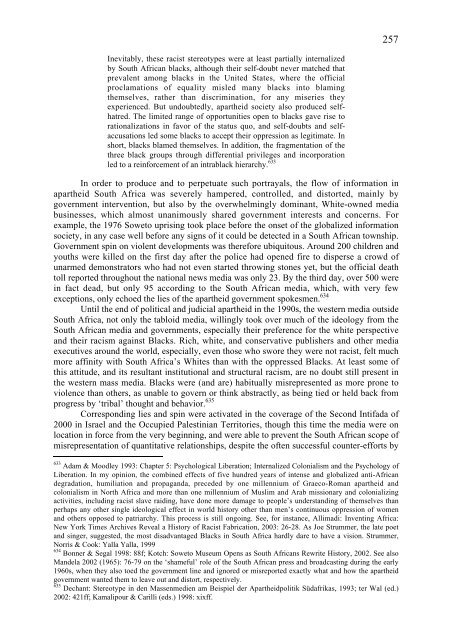Apartheid
Apartheid
Apartheid
You also want an ePaper? Increase the reach of your titles
YUMPU automatically turns print PDFs into web optimized ePapers that Google loves.
Inevitably, these racist stereotypes were at least partially internalized<br />
by South African blacks, although their self-doubt never matched that<br />
prevalent among blacks in the United States, where the official<br />
proclamations of equality misled many blacks into blaming<br />
themselves, rather than discrimination, for any miseries they<br />
experienced. But undoubtedly, apartheid society also produced selfhatred.<br />
The limited range of opportunities open to blacks gave rise to<br />
rationalizations in favor of the status quo, and self-doubts and selfaccusations<br />
led some blacks to accept their oppression as legitimate. In<br />
short, blacks blamed themselves. In addition, the fragmentation of the<br />
three black groups through differential privileges and incorporation<br />
led to a reinforcement of an intrablack hierarchy. 633<br />
257<br />
In order to produce and to perpetuate such portrayals, the flow of information in<br />
apartheid South Africa was severely hampered, controlled, and distorted, mainly by<br />
government intervention, but also by the overwhelmingly dominant, White-owned media<br />
businesses, which almost unanimously shared government interests and concerns. For<br />
example, the 1976 Soweto uprising took place before the onset of the globalized information<br />
society, in any case well before any signs of it could be detected in a South African township.<br />
Government spin on violent developments was therefore ubiquitous. Around 200 children and<br />
youths were killed on the first day after the police had opened fire to disperse a crowd of<br />
unarmed demonstrators who had not even started throwing stones yet, but the official death<br />
toll reported throughout the national news media was only 23. By the third day, over 500 were<br />
in fact dead, but only 95 according to the South African media, which, with very few<br />
exceptions, only echoed the lies of the apartheid government spokesmen. 634<br />
Until the end of political and judicial apartheid in the 1990s, the western media outside<br />
South Africa, not only the tabloid media, willingly took over much of the ideology from the<br />
South African media and governments, especially their preference for the white perspective<br />
and their racism against Blacks. Rich, white, and conservative publishers and other media<br />
executives around the world, especially, even those who swore they were not racist, felt much<br />
more affinity with South Africa’s Whites than with the oppressed Blacks. At least some of<br />
this attitude, and its resultant institutional and structural racism, are no doubt still present in<br />
the western mass media. Blacks were (and are) habitually misrepresented as more prone to<br />
violence than others, as unable to govern or think abstractly, as being tied or held back from<br />
progress by ‘tribal’ thought and behavior. 635<br />
Corresponding lies and spin were activated in the coverage of the Second Intifada of<br />
2000 in Israel and the Occupied Palestinian Territories, though this time the media were on<br />
location in force from the very beginning, and were able to prevent the South African scope of<br />
misrepresentation of quantitative relationships, despite the often successful counter-efforts by<br />
633<br />
Adam & Moodley 1993: Chapter 5: Psychological Liberation; Internalized Colonialism and the Psychology of<br />
Liberation. In my opinion, the combined effects of five hundred years of intense and globalized anti-African<br />
degradation, humiliation and propaganda, preceded by one millennium of Graeco-Roman apartheid and<br />
colonialism in North Africa and more than one millennium of Muslim and Arab missionary and colonializing<br />
activities, including racist slave raiding, have done more damage to people’s understanding of themselves than<br />
perhaps any other single ideological effect in world history other than men’s continuous oppression of women<br />
and others opposed to patriarchy. This process is still ongoing. See, for instance, Allimadi: Inventing Africa:<br />
New York Times Archives Reveal a History of Racist Fabrication, 2003: 26-28. As Joe Strummer, the late poet<br />
and singer, suggested, the most disadvantaged Blacks in South Africa hardly dare to have a vision. Strummer,<br />
Norris & Cook: Yalla Yalla, 1999<br />
634<br />
Bonner & Segal 1998: 88f; Kotch: Soweto Museum Opens as South Africans Rewrite History, 2002. See also<br />
Mandela 2002 (1965): 76-79 on the ‘shameful’ role of the South African press and broadcasting during the early<br />
1960s, when they also toed the government line and ignored or misreported exactly what and how the apartheid<br />
government wanted them to leave out and distort, respectively.<br />
635<br />
Dechant: Stereotype in den Massenmedien am Beispiel der <strong>Apartheid</strong>politik Südafrikas, 1993; ter Wal (ed.)<br />
2002: 421ff; Kamalipour & Carilli (eds.) 1998: xixff.

















